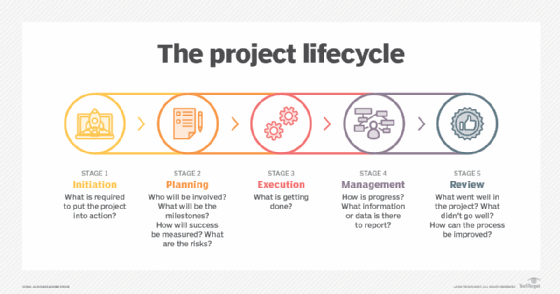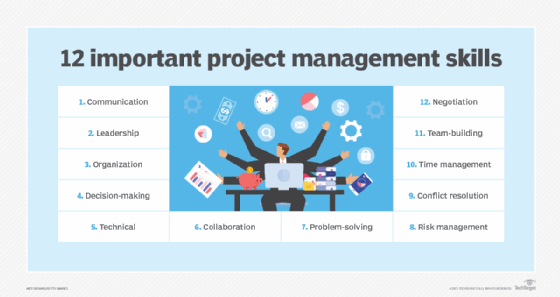What is a PMO (project management office)?
A project management office (PMO) is a group, agency or department that defines and maintains the standards of project management for a company. The PMO retains the documentation and metrics for executing projects and is tasked with ensuring projects are delivered on time and within budget.
The primary goal of a PMO is to achieve benefits from standardizing and following project management processes, policies and methods. PMOs are sometimes external to a company. Whether internal or outsourced, PMOs should embody the organization's corporate culture and strategy to be most effective.
As more companies with PMOs have received returns on investment, the popularity of the office has increased. Nearly nine in 10 organizations globally had a PMO as of 2020, according to Wellingtone, a PMO consulting firm.
What's the difference between a PMO and a project manager?
As the oversight body for an organization's projects, PMOs have a broad scope and are staffed by people from many disciplines. The office typically includes a mix of professionals from IT, planning, finance and risk management. They collaborate to ensure all projects meet the defined organizational outcomes. Not every organization needs a PMO, but most will need a project manager.
A project manager is the individual responsible for the overall control and success of a single project from start to finish. The project manager's job is to define project goals, gather data, schedule tasks and manage the resources, costs and budget. Project managers typically have strong leadership and communication skills. They often oversee project teams from multiple functional areas that must work together during the project to reach its goal.

What are typical PMO job titles?
Various job titles fall within the purview of a project management office. PMO staff typically are experienced project management professionals; many have earned the PMI Project Management Professional certification. Staff should include people with budgeting, scheduling, planning and organizational experience. The full scope of positions include the following:
- PMO manager. This is the top position that oversees operations and ensures other members are following established methodologies, procedures and timelines.
- Project manager. This person works alongside the PMO manager to manage and address constraints to individual projects. They coordinate the work of other PMO members to ensure project needs and deadlines are met.
- Project coordinator. This person supports the project manager in tracking progress and helping ensure projects are going according to plan. Project coordinators perform other tasks, such as organizing meetings and reporting to stakeholders on the status of projects.
- Project portfolio manager (PPM). Organizations with large project portfolios require PPMs. Even after a project is completed, a PPM continuously assesses it and determines its business value.
- Project analyst. A project analyst uses data on the progress of the project as well as broader market trends to provide guidance to the project and PMO managers. This information helps managers with decision-making.
- PMO process specialist. This role understands the ins and outs of all policies and procedures relevant to the project and helps the manager ensure everyone follows them.
- Project assistants. Assistants help with routine administrative tasks and assist the other project team members. Depending on the size of a PMO's projects, these offices can employ many assistants.
PMO roles and responsibilities
A PMO is responsible for guidance, documentation and metrics related to the management and implementation of projects. The office gets involved in project-related tasks and follows up on project activities through its lifecycle. It might also report to senior management on project metrics, activities, problems and requirements as a way to keep implementers and decision-makers moving toward consistent business goals and objectives.
A PMO bases its project management principles, practices and processes on an industry-standard program management methodology such as the following:
- Agile. The Agile method applies to projects that require speed, flexibility and continuous delivery of products to customers in short delivery cycles. Agile project management is an iterative approach to planning and guiding project processes. It breaks them into smaller cycles called sprints, or iterations.
- Waterfall. The Waterfall methodology enables increased control during each phase of a project but can be inflexible if project scope changes occur.
- Scrum. This term, based on the formation of players in the game of rugby, is a part of the Agile framework. Its deliverables are due every 30 days. Workgroups that have had difficulty in prioritizing work can improve productivity when they switch to the Scrum methodology.
- Six Sigma. This methodology is used to improve processes. Six Sigma gets rid of what are considered defects -- or a product or service that doesn't conform to its specifications.
What are the benefits of a PMO?
A PMO provides several benefits, including standardized project management methodologies and procedures. A centralized approach to project planning helps ensure clarity and consistent, accurate results. In some cases, this can result in decreased project costs because the PMO is responsible for setting accurate time, cost and resource estimates. Oversight can lessen the likelihood of revisions during a project.
Having a PMO ensures that individual projects align with an organization's goals. The office also acts as the central repository of different types of knowledge. For example, the PMO can flag similarities among projects and provide information and resources to different project management teams to facilitate completion and avoid having to reinvent the wheel.
A PMO is typically tasked with identifying and training project managers and providing professional support. This produces staff who are better trained, which helps ensure project success and can lead to employee retention.
What challenges come with a PMO?
Even the most organized PMO is bound to hit some roadblocks. These could include failing to set appropriate objectives, goals and milestones, as well as poor stakeholder management and resource allocation.
Scope creep is another common issue that can occur when a project's requirements change from what was agreed to at the outset. This can lead to budget overruns that can cascade and affect multiple projects the PMO oversees.
Further, challenges to project progress can result if the PMO isn't given the appropriate level of authority, if it lacks support from top management, or if its scope isn't clearly defined. Other challenges that undermine or derail a PMO initiative include the following:
- Lack of communication between the PMO and team members.
- Teams that lack the right skill sets.
- Lack of visibility into a team's work.
- Failure to anticipate or adequately resolve team conflicts.
Considerations before starting a PMO
A successful PMO needs people with a range of skills. The Project Management Institute (PMI) has identified the following "power skills" as a necessity for project management experts: communication, conflict management, emotional intelligence, empathy, negotiation, problem-solving and teamwork.
The institute defines power skills as "abilities and behaviors that facilitate working with others and help project professionals to succeed in the workplace." It divides these skills into two categories: the essential skills listed above and various types of leadership styles.
PMOs should also provide formal training to project managers.

Types of PMOs
There is no standard approach to PMO development. However, an effective PMO is always strongly aligned with the organizational strategy of the company.
Some enterprises have a supportive or advisory PMO, which compiles and stores an organization's projects but plays more of a consultative role. This type of PMO will provide advice based on knowledge gleaned from past projects. Many organizations have department-specific, regional or divisional PMOs.
The type of PMO with the greatest level of managerial control has the power to enforce organizational and project management standards and practices. This is sometimes referred to as a directive PMO, which acts as the central authority on projects.
How a PMO is designed for maximum effectiveness depends on a variety of organizational factors, including targeted goals, traditional strengths and cultural imperatives.
Historically, there are three organizational structures for project management offices:
- The project repository. This model occurs most often in organizations that empower distributed, business-centric project ownership or in enterprises with weak central governance. The project office serves as a source of information on project management frameworks. Project managers continue to report to, and are funded by, their respective business units.
- The project coach model. This model assumes a willingness to share some project management practices across business functions and uses the project office to coordinate and streamline communication. Best practices are documented and shared, and project performance is monitored actively. The PMO in this model is a permanent structure with staff and has some supervisory responsibility for all projects.
- The enterprise project management office. The EPM model assumes a governance process that involves the PMO in all projects, regardless of size. It's able to assess scope, allocate resources and verify time, budget, risk and impact assumptions before the project is undertaken. Funding is generally a combination of direct budgeted allocation for baseline services and a fee-for-service charge for others.
How to structure an effective PMO for your organization
The four essential capabilities to successful project completion, according to a recent PMI report are communication, problem-solving, collaborative leadership and strategic planning. Nine out of 10 project managers believe these power skills help them work smarter, the report said. Hiring project managers with these skills is critical to PMO success.
PMOs should also have a consistent approach to projects, such as one of the following:
- Controlling. This PMO approach requires projects to comply with policies, documentation and workflows. Members regularly conduct project reviews. This type of PMO works well for high-risk industries.
- Supportive. A supportive PMO provides guidance for projects in situations where it isn't mandatory to consult with a PMO for expertise, training, mentoring or resources such as templates, but it could help.
- Directive. This PMO approach is directly involved in managing projects alongside other teams. It provides expertise on the spot and expedites projects instead of reviewing completed projects as controlling PMOs do.
How to select PMO tools and software
Project management tools and software help keep projects on track. They centralize data and give all stakeholders access from multiple devices. Some features to look for when vetting these tools include the following:
- Ease of use.
- Customization.
- Scheduling.
- Automated tasks and notifications.
- Time management.
- Collaboration.
- Project reporting.
- Dashboard analytics.
- Flexibility.
- Integration.
PMO software and tools have evolved with technology and workplace trends, such as the expansion of cloud computing and the emergence of artificial intelligence (AI) and remote or hybrid work. For example, business intelligence applications now rely on AI algorithms to analyze large volumes of market data, which guides PMO members' decision-making.
Learn more about how AI is transforming project management.







